
 |
|
|
#1 |
|
Member
Join Date: Jul 2006
Location: musorian territory
Posts: 481
|
well, here we are always talking about swords and spears and such..
but now what about some folding knives then  the first foto next to the okapi knife it is a factory made version of a type of dagestani folding knife. with a wood handle. the next two are hand made, with forged convex ground blades and plexi glass handles with colored tinfoil underneath,, this is the more common dargins made folder, made in the village of khabouk, comes with a pistol grip sort of shape grip, there is also several other styles of handle shape used, some more like the french and italian gunstock shaped pocketknife handles.. here is a Lak made folding knife with a locking blade from dagesan it is with a pink plexiglass handle,, actualy the foilunder is pink ,, made by a mamber of the lak ethnic group.. i beleive the khabouksky style of folding knife well predates communisim and proably originates some time in the earily 19th centuary when factory made goods began to arrive from russia and europe and folding knives would have been introduced.. ive not seen any very old exsamples.. as i suspect these were just worked till they fell apart,,.. older ones normaly have buffalo horn handles,, , but the style hasn't changed much, the first knife with the pink scales is about 30 or 35 years old and the other with green scales it is only 2 or 3 years old.. so here is a dagestani folding knife........ what other ethnographic folding knives from around the world have peoples here.. Last edited by ausjulius; 12th October 2008 at 08:56 PM. |
|
|

|
|
|
#2 |
|
Member
Join Date: Oct 2008
Location: between work and sleep
Posts: 731
|
the 'pachihlan' folding knife from Shihling in Taipei, Taiwan is pretty unique...
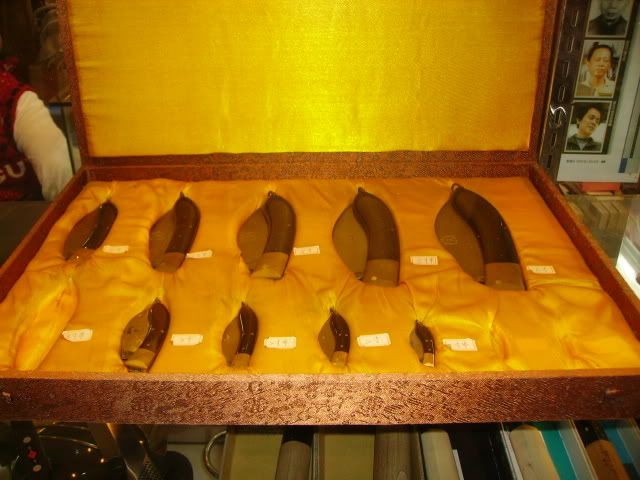
|
|
|

|
|
|
#3 |
|
Member
Join Date: Jul 2006
Location: musorian territory
Posts: 481
|
ah interesting, yes ive seen these knives before , some are rather well made also,
is there anyone still making them now? i wounder if they are a european influnce ,, and if they ar eonly on taiwan,, as after all the portagese and dutch were the original colonists there with the chinese comming while the islands were under european control, maybe this pocket knife was derived from a european folding knife, ive seen quite alot of chinese friction folders from mainland china but none with a back spring on the blade. \ |
|
|

|
|
|
#4 |
|
Member
Join Date: May 2006
Posts: 7,133
|
I like folders.
I've got a lot of folders. I do not collect them, I accumulate them. Indiscriminately. I buy $1 ones with broken handles and blades and fix them and sharpen them, and use them as bench knives. In fact, any folder that I see that isn't too expensive , I buy. This one is one of my more unusual ones. Its probably about as ethno as an ethno folder could be. I would have posted pics of it before now, but I had lent it to a friend. I don't know what it is, or where its from, but my guess is that it is a carpet maker's knife. |
|
|

|
|
|
#5 |
|
Member
Join Date: Dec 2004
Location: Kernersville, NC, USA
Posts: 793
|
My only ethnographic folder.
 A rather touristy folding Lohar from Afghanistan. A rather touristy folding Lohar from Afghanistan.Steve 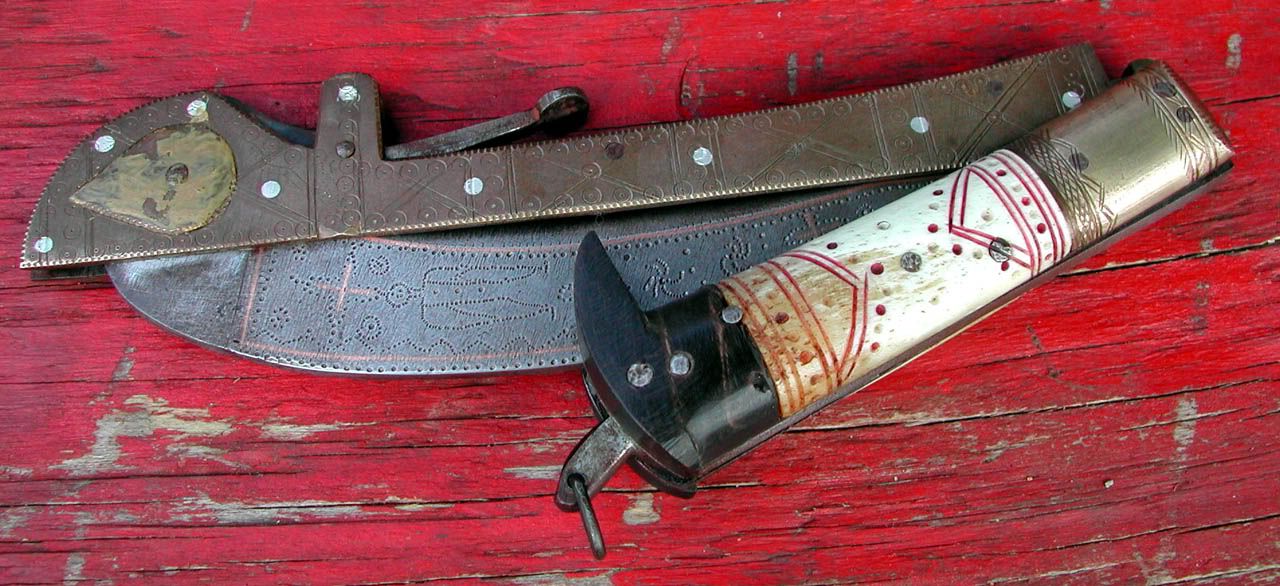 
|
|
|

|
|
|
#6 |
|
Keris forum moderator
Join Date: Aug 2006
Location: Nova Scotia
Posts: 7,261
|
I dunno Steve...it may be a bit "touristy", but it's cool!
 I wonder though about including some of these factory manufactured folders in here as ethnographic. I guess i don't expect ethnographic blades to all be carbon copies of each other as these factory ones are. They may have an ethic style, but is that enough to tag them ethnographic? 
|
|
|

|
|
|
#7 | |
|
Member
Join Date: Oct 2008
Location: between work and sleep
Posts: 731
|
Quote:
an example of that can be seen with Lorchas... ships that combined the European sea-going hull with the Chinese sails... best of both worlds so to speak... so an age-old Chinese blade design and a European folding mechanism? not impossible... but I plan to get some of those folders within a few months so maybe I can comment on this better later on  EDIT: yes there is one maker left as far as I know... he's in the Shihling part of Taipei, Taiwan |
|
|
|

|
|
|
#8 |
|
Member
Join Date: May 2006
Posts: 7,133
|
Here's another Chinese folder.
I use this as a garden knife. It is unusual in that the liners are of a single piece of steel that has been bent over the spring. |
|
|

|
|
|
#9 | |
|
Member
Join Date: Nov 2006
Location: The Netherlands
Posts: 2,238
|
Quote:
I have had one of these too and was told it was from eastern India. The seller traveled to India and eastern asia regularly to buy his stock. They told me that it had something to do with cleaning coconuts, but it I can imagine that the construction is a bit to fragile for that job. Any guess is worth as much as mine. |
|
|
|

|
|
|
#10 |
|
Member
Join Date: May 2006
Posts: 7,133
|
Thanks for your input, Asomotif.
I've seen a total of three of these. One of the other ones was about the same as mine, and one was of really excellent quality with an ivory handle. The ivory handle one was with a batch of artifacts on sale in a carpet gallery. I have seen a documentary on carpet making in Iran where the knife being used by the girl doing the work appeared to be similar to these knives, but as you can imagine, all I got was a fleeting glimpse of the knife, whilst it was in use. In my household, we use coconuts as a regular part of our diet. My wife takes the shell off with big heavy knife. We don't use the coconut water, but if we did want to use it, she would simply take off a part of the shell, and then open the flesh. Seeing the way coconuts are handled for food, its a bit hard to imagine how a small, light folder could have any relationship to a coconut. As you say, at this point, any guess is a good one. |
|
|

|
|
|
#11 |
|
Member
Join Date: Oct 2008
Location: between work and sleep
Posts: 731
|
I love coconuts in food and on it's own... a good golok or machete to chop it open and drink its juice... and then scoop out the meat....
the way the meat is harvested and processed is usually that it is scooped or cut out and then left out to dry in the sun... (so I've heard) if the knife has anything to do with coconuts it's probably to do with the more delicate part of scooping out the meat? or perhaps it is used to shave off the hairs (if the brown hairy type) and using the coconut fibers to make things... I don't know how many people still use coconut fibers to make rope and such though 
|
|
|

|
|
|
#12 |
|
Member
Join Date: May 2006
Posts: 7,133
|
To remove coconut meat, you use a big knife to take the shell off, bit by bit, you don't scoop it out of the shell. Somebody who is skilled at this can do it with a couple of well placed blows, and without damaging the meat.
In Solo my servant uses a bendho to remove the shell, here in Australia my wife uses a little old machete, only about 15 inches long.In fact, any sort of heavy knife will do, but it should be sharp.If its not sharp, you can still get the shell off, but you don't get the meat out in one piece. I've got a vague memory of seeing professionals de-shelling coconuts, and I think they use a blade that curves away from them, and is anchored in the ground, or in a bench, and they bring the nut down onto it. |
|
|

|
|
|
#13 | |
|
Member
Join Date: Nov 2008
Posts: 3
|
Quote:
 
|
|
|
|

|
|
|
#14 |
|
Member
Join Date: Mar 2006
Location: Room 101, Glos. UK
Posts: 4,263
|
here's a recent hand made bulgarian friction folder.
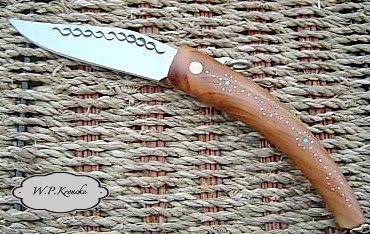 and some ring-locks 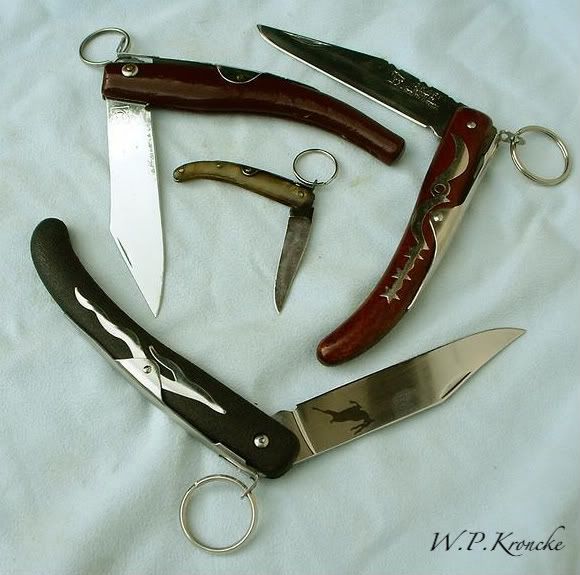 the kudu is a cold steel copy of the okapi, with fancier hardware & a modern glass reinforced zytel handle. the okapi, made in so. africa, was originally made in solingen, but they licensed it to SA, the other large one with the more abrupt clipped point has an outline eagle head in a circle in a square stamped on the blade. i think it's an earlier german one. the teeny one (2in. blade) with the horn handle is an older spanish variant. they are a variation on the ratcheting navaja design from spain, here is a six and a three inch blade version, the lever near the pivot lifts the lock pawl, similar to the ring pull type. there are five ratchet teeth the pawl clicks over on opening, preventing it from being pushed back and closing on the owners hand in case of a fight. the lever normally lies flat against the back of the grip, is raised 90 degrees to unlock the blade for folding. i've partially lifted them here for clarity. 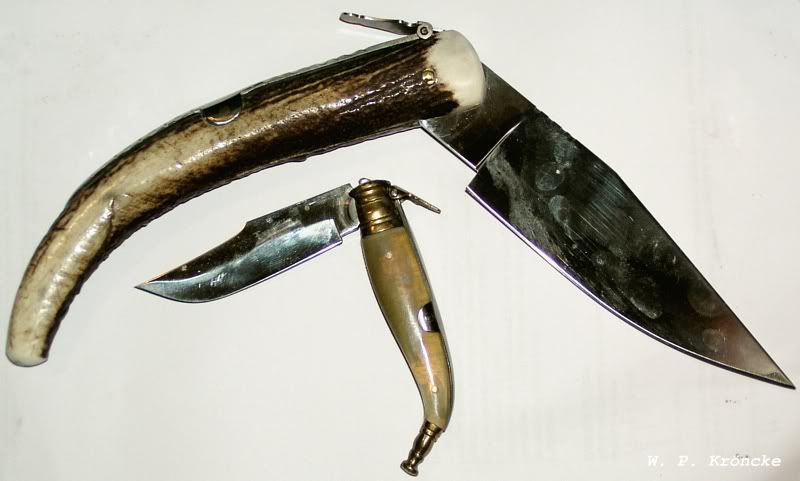 they say the sound of the lock pawl clicking over the ratchet teeth was the scariest sound , and for some the last sound they ever heard, in a spanish bar... the okapi is known to have killed more men in so. africa than any other knife. Last edited by kronckew; 27th November 2008 at 12:35 AM. |
|
|

|
|
|
#15 |
|
Member
Join Date: Mar 2006
Location: Room 101, Glos. UK
Posts: 4,263
|
another ethnic folder i like is the barrel knife from sweden, they are each unique and the parts are not interchangeable.
this is sometimes referred to as an '1874' model as that was when it was 'patented' in the USA by a maker who had learned to make them in sweden, one of the swedish makers, john engstrum stamped his with the date he started making them, also 1874, this is NOT necessarily the mfg. date, he made them from 1874 thru 1918 and all were stamped 1874. they were made from 1864-1925 by the major mfg. mine is a p. holmberg, made between 1900-1920, 2.75 in. barrel. photos showing how it's opened (reverse sequence to close  ) )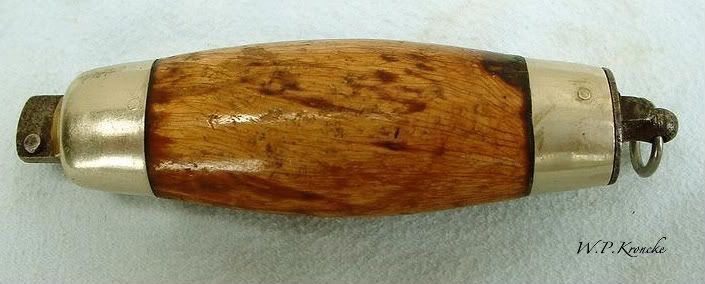 closed 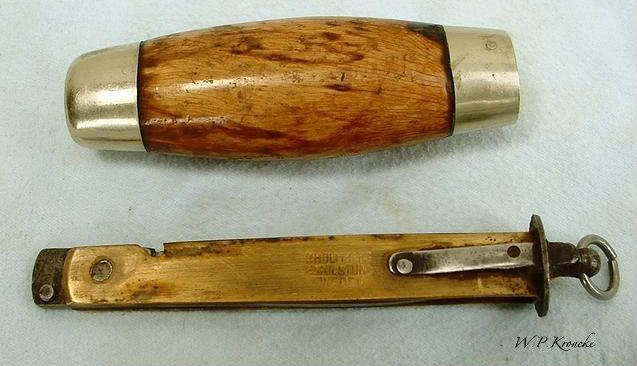 unlocked and removed from grip - there is a little spring loaded pawl/lever near the ring 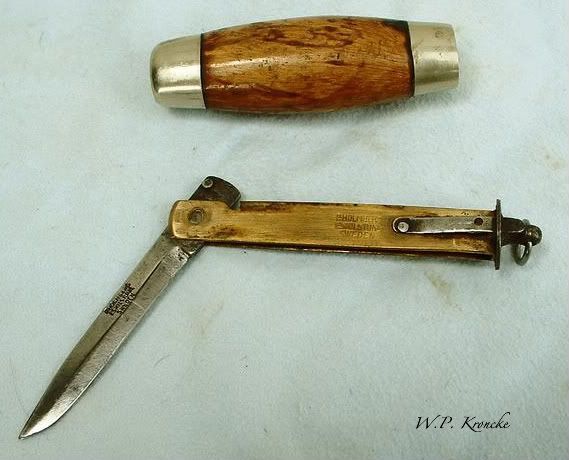 blade swinging into position. you can see the little spring locking thingy  reinsterted and locked into grip and you have a nice scandi fixed blade knife. |
|
|

|
|
|
#16 |
|
Member
Join Date: Oct 2008
Location: between work and sleep
Posts: 731
|
For those interested, I found the website of the traditional knife-maker in 士林, Taipei, Taiwan. I believe he is 5th generation in the practice, making these traditional bamboo-leaf shaped blades. He has no apprentices as far as I know. There's a price list and sampling of the hand-made / custom-made 士林刀! Here's also a short youtube video of him. I've ordered a blade with him, and it should be done in November (he has me in the queue).
 I am not sure if I am allowed to post his website as it is a commercial site (though not an "ongoing auction"). I think he also has a partnership that is a multi-person assembly process that makes decent but not quite as good knives. |
|
|

|
|
|
#17 |
|
Member
Join Date: Jan 2005
Location: Haifa, Israel
Posts: 183
|
Regarding the small folder posted by Maisey, thus was discussed before in the forum. See http://www.vikingsword.com/vb/showthread.php?t=918
|
|
|

|
|
|
#18 |
|
Member
Join Date: Nov 2006
Location: The Netherlands
Posts: 2,238
|
Thanks !
|
|
|

|
|
|
#19 |
|
Member
Join Date: Dec 2008
Posts: 84
|
The folding knife posted by Alan Maisey is a knife used by scribes. The blade is a multiple use blade including the preparing of the 'ola leaf' of the palm tree on which traditionally writing was done. The point is a stylus with the use of which images are scraped on the palm leaf and blackened in with charcoal and oil or some other substance. This example is from South India; the script appears to be Tamil.
Certain Pihakaettas from Sri Lanka that still retain their sheath have a seperate channel to hold the stylus. These knives are a portable version of same. By the way I have one of these knives where the stylus has rusted into the grip and cannot be removed. The grip is of wood. Any advice on how I could release the stylus would be appreciated. The carpet makers knife has a small nick at the end of the point to catch the string and pull it through. |
|
|

|
|
|
#20 |
|
Member
Join Date: Dec 2008
Posts: 84
|
Here is an ola leaf written with a stylus. The script is sinhalese and the contents is Ayurvedic text.
By the way the wood of the grip in Alan Maiseys example also looks like coconut or some other such palm? |
|
|

|
|
|
#21 |
|
Member
Join Date: May 2006
Posts: 7,133
|
Thank you Anandalal for what I believe to be the correct ID of the folder I posted a pic of in post #4.
I obtained this knife from an importer of hand woven carpets, and it was he who suggested that it was in fact a carpet maker's knife. Perhaps it was, but probably not used for making carpets. Your explanation makes perfect sense. Again, my thanks. |
|
|

|
|
|
#22 |
|
Member
Join Date: Dec 2004
Location: Sint-Amandsberg (near Ghent, Belgium)
Posts: 830
|
I'm a bit like Alan. When I visit a fleamarket and I see an inexpensive folder, I just buy it. Goes together with the rest.
I've been doing this since I was in school (and that's a long time ago). From every schooltrip, I returned with a small knife. Must be in my blood  Just can't help it. Just can't help it.When we (from the States or Europe) talk about etnographic knives, we always think about knives from China, Japan, Afghanistan, etc.... People living on that side of the planet might consider European knives also as typical and etnographic. Here are some which might fit into that category : Opinel, Albacete and the unknown knife with horn grip.  Finally a portion of what I found the past few years : from tourist knife to Swiss knife. And there are a lot more in my collection.  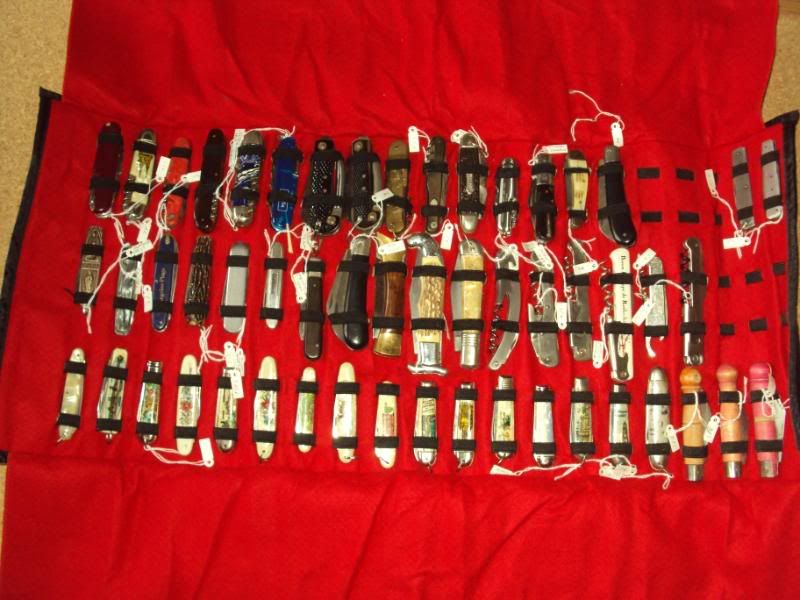 |
|
|

|
|
|
#23 |
|
Member
Join Date: May 2006
Posts: 7,133
|
Well Freddy, you're a bit better organised than I am.
Here's some of my indiscriminate accumulation --- how they're stored and most of what's in that drawer laid out. |
|
|

|
|
|
#24 |
|
Member
Join Date: Oct 2005
Location: Paris (FR*) Cairo (EG)
Posts: 1,142
|
Hi
I'm a mountaineer, and we are belong an ethnie, the "Rouergat"  our tradition is to have a folding knife multi-purpose, since 1829 there is a famous blacksmith, Calmels, who is manufacturing the "Laguiole knifes", he still yet manufacturing, and trading his knifes "ONLY" in his shop of Laguiole city (12210 - Aveyron - France) unfortunatly, in our days, those knifes are to much fashionable, and there are too many copies from everywhere ... even China ... under the name of "Laguiole"  here on display, only "Calmels Laguiole"  ŗ + Dom |
|
|

|
|
|
#25 |
|
Member
Join Date: May 2006
Posts: 7,133
|
Yeah, there are a lot of copies of these knives. The ones I've shown are by Maki, David, and one unbranded one that except for the fact that it was purchased by a close friend from a small maker in South France, when she was living there, you could easily take as Pakistan or Chinese production.
If there is an Aussie ethnic folder its the three blade stock knife. |
|
|

|
|
|
#26 |
|
Member
Join Date: Dec 2004
Location: Sint-Amandsberg (near Ghent, Belgium)
Posts: 830
|
Not everything is so well organized, Alan. Most of the pocket knives are stored in boxes (for the tin boxes, I have to eat a lot of cookies
 ). ).I keep the smallest ones in plactic bags. I also tag them, so I know when and where I bought them and what I paid. 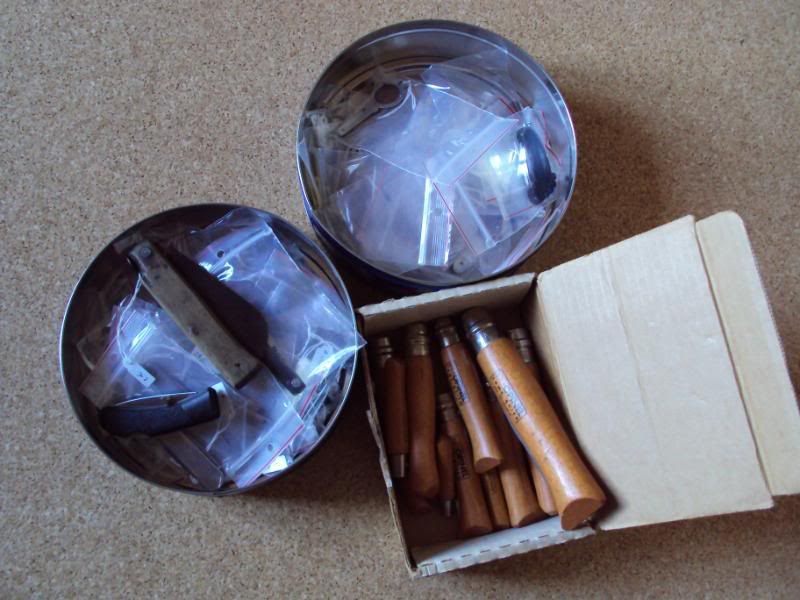 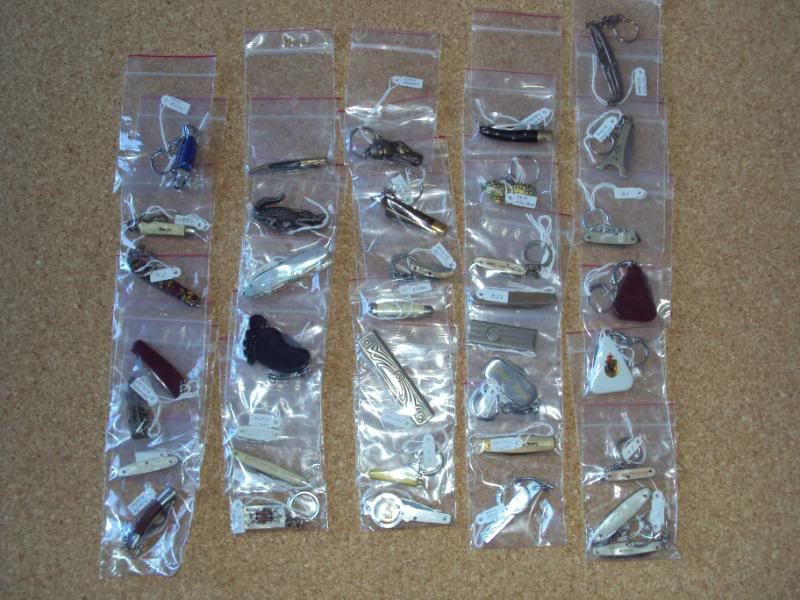 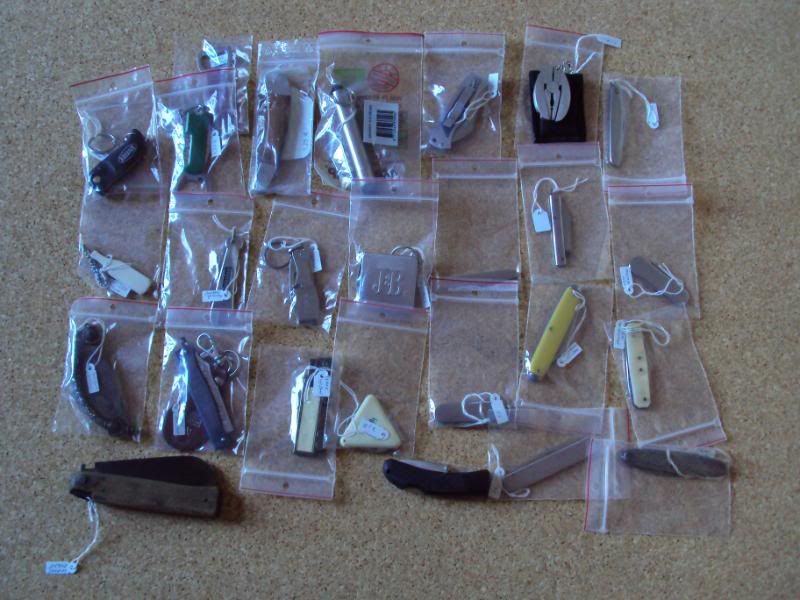 I'll show you two nice ones. First is dated 1923. I think it's the oldest pocket knife I have. The other one could be considered an etnographic pocket knife. It's a handmade knife from Turkey. The blade has the maker's name stamped on it : BILAL CAN. It has a simple blade and a horn handle. 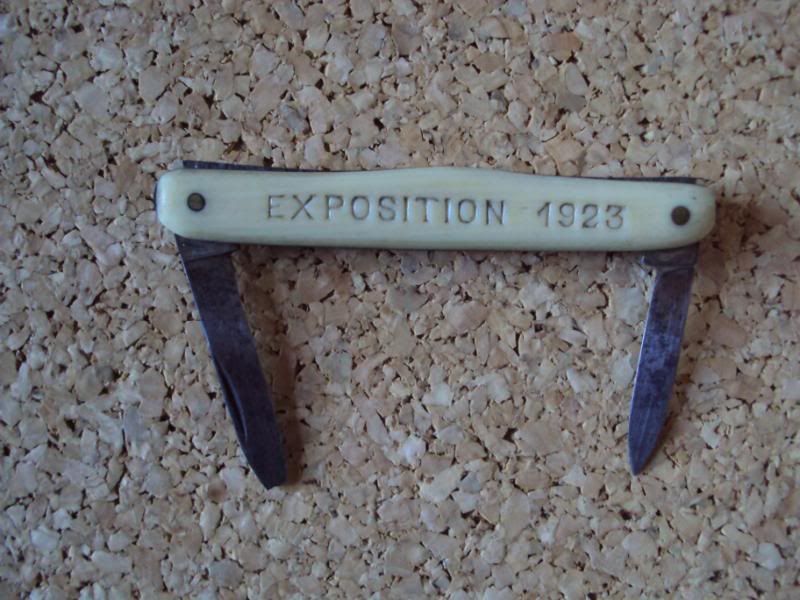 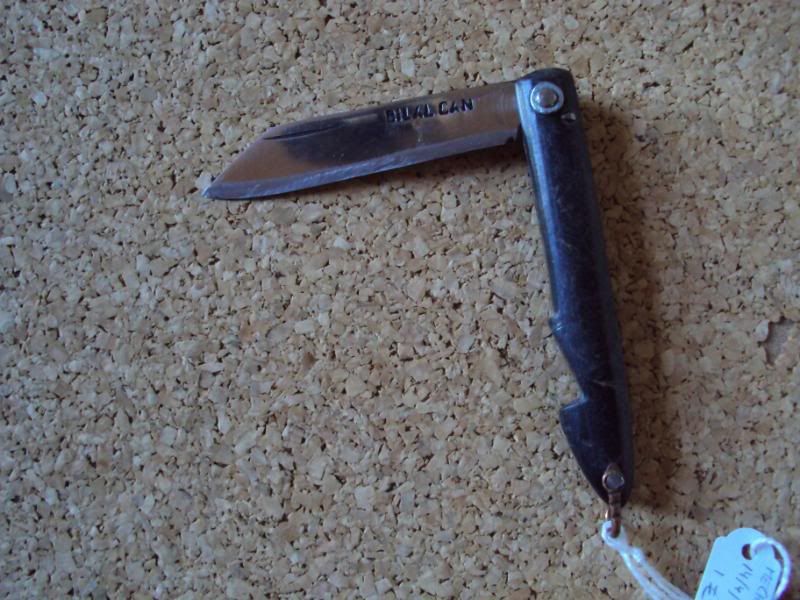  |
|
|

|
|
|
#27 |
|
Member
Join Date: May 2006
Posts: 7,133
|
Yes Freddy, as I said:- organised.
The knives I'm showing here are the ones I have readily accessible in a drawer. I've got others all over the house and workshop. The ones in the drawer are only storedas you see. No grouping, no plastic bags, I get a new knife I just put it in the drawer. Here are few that may perhaps be interesting. A--- dates from 1878, a star/cross B--- my mother's knife from 1939 C--- my grandfather's knife from pre-1914 D--- a group that I believe pre-dates 1920 E--- a couple of early multi-purpose knives F--- a couple of hobo sets, the nickel one from the WWI period, the horn handle one I believe from pre-WWII G--- a group that I believe pre-dates WWII |
|
|

|
|
|
#28 | |
|
Member
Join Date: Jul 2006
Location: musorian territory
Posts: 481
|
Quote:
NEXT TO THE OKAPI KNIFE...... is a factory made version of a dagestani folding knife,, the knife below the okapi knife........ okapi is a french style knife made by a german firm for trade in africa now made in south africa... not a ethnograpic knife but surly resembling some from france and southern europe in many ways.. |
|
|
|

|
|
|
#29 | |
|
Member
Join Date: Mar 2006
Location: Room 101, Glos. UK
Posts: 4,263
|
Quote:
i throw in a gratuitous photo of my marjacq knife with it's ebony grip, another french ethnic design still in production. neat ring lock that not only locks in the open position like the opinels, but in the closed position as well. i gather that opinel has now modified their design to include a similar functionality that was not there in my earlier opinels.  we have yet to see the butterfly knives that i somehow think of as filipino...i'll have to dig out a photo of mine, i think there is one traditional one amoungst some of the more 'tactical' designs.... Last edited by kronckew; 13th September 2009 at 08:02 AM. |
|
|
|

|
|
|
#30 |
|
Member
Join Date: Feb 2006
Posts: 31
|
Well...there are some funny stuffs above here.
|
|
|

|
 |
|
|